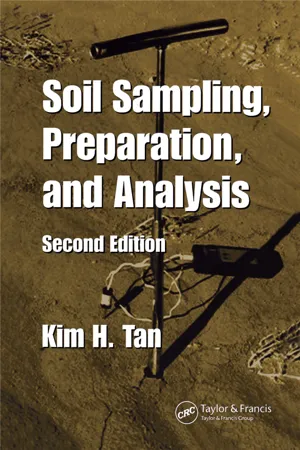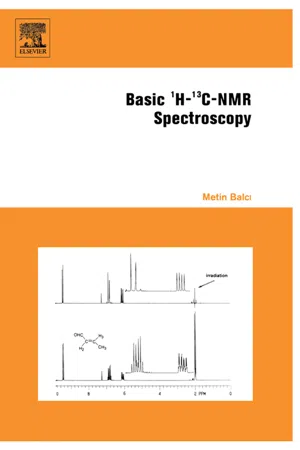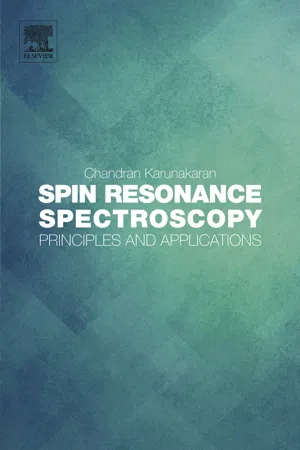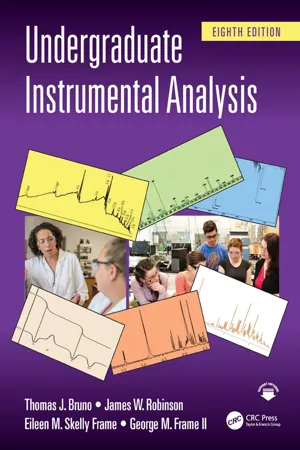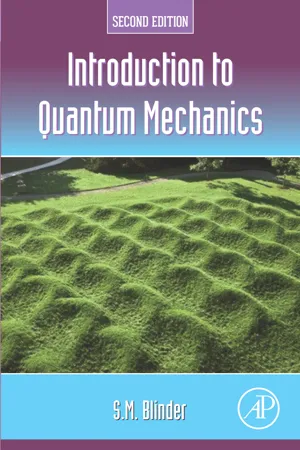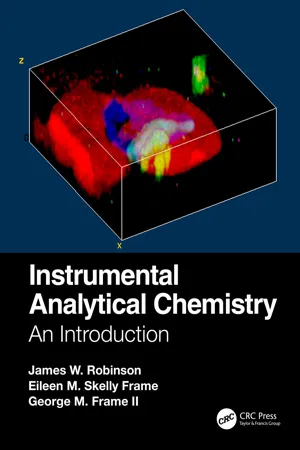Chemistry
Chemical Shift nmr
Chemical shift in NMR (nuclear magnetic resonance) refers to the displacement of a nuclear magnetic resonance signal in a magnetic field. It is measured in parts per million (ppm) and provides information about the chemical environment of the nucleus being studied. Chemical shift values are influenced by the electron distribution around the nucleus, making it a valuable tool for structural determination in organic chemistry.
Written by Perlego with AI-assistance
Related key terms
Related key terms
1 of 4
Related key terms
1 of 3
10 Key excerpts on "Chemical Shift nmr"
- eBook - ePub
Optical, Electric and Magnetic Properties of Molecules
A Review of the Work of A.D. Buckingham
- D.C. Clary, B.J. Orr(Authors)
- 1997(Publication Date)
- Elsevier Science(Publisher)
11 NMR chemical shifts: theory and experiment Cynthia Jameson, A review of reprinted paper [B54]: ; Medium effects in proton magnetic resonance. I. Gases W.T. Raynes, A.D. Buckingham and H.J. Bernstein J. Chem. Phys., 1962, 36, 3481–3488 Nuclear magnetic resonance spectroscopy is a powerful technique that is used very widely in the characterization of systems ranging from simple molecules in low-density gases to molecules in biological systems, whole tissues or even whole animals, as well as materials complex and heterogeneous, such as polymer blends and catalysts. The NMR parameter which permits the dispersion of nuclear resonance frequencies into separate signals at separations proportional to the strength of the applied magnetic field is the nuclear magnetic shielding. The difference between nuclear shielding values in two different nuclear sites is called the NMR chemical shift. The extreme sensitivity of the nuclear shielding to the electronic environment gives rise to the dispersion of resonances; for example the 13 C nuclei of the alpha carbons of the various alanine residues in a protein all have different resonance frequencies each of which is different from the free amino acid. In a series of papers [B40, B41, B54], Buckingham introduced the idea of additive contributions to NMR chemical shifts arising from molecular interactions with solvent molecules. The individual chemical-shift contributions identified are as follows: bulk susceptibility σ b, magnetic anisotropy σ a, electric-field effects σ E, and van der Waals σ W. These papers constitute the framework on which nearly all attempts at the interpretation of the relation of the proton chemical shifts in proteins to the secondary structure are based. In the recent past, the powerful multidimensional NMR methods of determining protein structure in solution made no use at all of the chemical shift information which is a natural byproduct of the resonance frequency assignment step - eBook - ePub
- Kim H. Tan(Author)
- 2005(Publication Date)
- CRC Press(Publisher)
Relaxation time can be relatively long (in the order of hours) in NMR analysis of solids or viscous liquids. This would usually result in the development of broad-line spectra. Relaxation time is, however, considerably faster (1 to 20 seconds) with liquids and gases, and the much shorter relaxation times generally yield sharper narrow-line spectra.20.3 Chemical Shift
An NMR spectrum is usually presented with and interpreted by units, called chemical shifts, δ. Each absorption signal in the spectrum is assigned a chemical shift value. It is defined as some unitless number, but its value is commonly expressed in terms of ppm (part per million).Slightly different versions of explanations have been given for what exactly a chemical shift is. Pfeffer and Gerasimowicz (1989) indicate that each nucleus has a third localized magnetic field B0 σ, produced by the electronic currents in the atoms, in which σ is called the shielding constant. Without the shield-effect all the nuclei would absorb at the same frequency. The presence of σ is then the reason for the different nuclei in the atoms of the sample to absorb energy at slightly different resonance (frequency) positions. The value of these resonances compared to that of a standard is called a chemical shift and is formulated as follows: in which δ = chemical shift in ppm units, vs = resonance frequency of sample, and vr = resonance frequency of the reference or standard.The chemical shift can be positive or negative in signs. A positive δ value suggests the presence of a greater degree of shield-effect in the sample.δ =(20.2)×v s−v rv r10 6In contrast, Willard et al. (1974) believe that the shielding factor, σ, is the nondimensional constant, which may be either positive or negative. They assume that electron clouds are providing the shield, and each group of nuclei is supposed to be shielded differently by these electron clouds. The denser or thicker the clouds, the higher the magnetic field that must be applied to penetrate the shield for producing detectable resonance signals from the nuclei. The assertion is made that the use of NMR spectrometers with different field strengths would yield different resonance signals, making comparisons very difficult. They feel that it is necessary to have one common magnetic field-independent expression for the assignment of the resonance peaks. The magnitude of the resonance peak of the sample against that of a standard, in field-independent units, is also taken as the chemical shift, but its formulation is somewhat different from equation (20.2). Willard and coworkers use v1 (operating frequency of the spectrometer) as the denominator instead of vr - eBook - ePub
- Metin Balci(Author)
- 2005(Publication Date)
- Elsevier Science(Publisher)
3Chemical Shift
Publisher Summary
This chapter discusses the chemical shift occurring in nuclei and begins with a discussion on local magnetic fields around a nucleus. The behavior of electrons in an atom when applied to external magnetic field induces circulations in the electron cloud surrounding the nucleus causing the electrons to generate their own magnetic fields. Chemical shifts are measured with reference to the protons of proposition of a resonance signal in a NMR spectrum. The preparation of the sample for the measurements of NMR spectra is as important as the recording of the spectra. The chapter explains the choice of a suitable solvent for the determination of the NMR spectra that largely depends on the solubility of the selected solvent of the compound to be studied. The physical properties of solvents that are important for NMR spectroscopy is presented in a tale and the factors influencing the chemical shift are discussed. The magnetic anisotropy of carbon–carbon and carbon–hydrogen bonds and their effect on chemical shifts are illustrated using figures. Exercises are provided at the end to propose a plausible structure for the given H-NMR spectra.3.1 LOCAL MAGNETIC FIELDS AROUND A NUCLEUS
In the previous chapter we explained that the following criterion has to be met in order to bring a nucleus into resonance:v = γ(13)H 02 π(13)As we have seen before, the gyromagnetic ratio, γ, is a constant characteristic of a particular nucleus. The proton has a definitive magnitude for the gyromagnetic ratio (see Table 2.1 ). The different chemical environment does not have any effect on the gyromagnetic ratio. Consequently, only a single proton peak is to be expected from protons of all kinds in a given magnetic field, in accordance with the basic NMR equation (eq. 13 ). In this case, the nuclear magnetic resonance spectroscopy would allow us to provide the information about the type of nucleus, the elemental composition (C, N, O, etc.), which are characterized by their individual resonance frequencies. Then, proton NMR spectroscopy would provide information whether a proton is present in a compound or not. However, there are much simpler techniques for determining the presence of protons, such as elemental analysis. The fact that all protons do not have a single resonance frequency according to eq. 13 was the main factor leading to the development of NMR spectroscopy. Since different protons have different resonance frequencies, we have to try to understand this phenomenon in relation to eq. 13 - eBook - ePub
Pumps, Channels and Transporters
Methods of Functional Analysis
- Ronald J. Clarke, Mohammed A. A. Khalid, Ronald J. Clarke, Mohammed A. A. Khalid(Authors)
- 2015(Publication Date)
- Wiley(Publisher)
δ, as follows:(8.2)where ν0 is the resonance frequency (typically in the MHz range) of a particular set of nuclear spins in a reference compound and νsample is that of the spins in an individual moiety in the sample. The chemical shift of nuclear spins in a particular chemical location in a molecule is independent of the magnitude of B0 . Therefore, spectra from different NMR spectrometers can be directly compared in terms of the chemical shifts of the spectral peaks (more correctly referred to as resonances).8.1.6 Free Induction Decay
An NMR spectrum is generated from the response of the nuclear spins in a sample to an RF pulse (or a sequence of pulses), usually of a few microseconds duration (see Fig. 8.1 for a set of valuable pulse sequences). An RF pulse induces a coherence of the directions of magnetization vectors of the nuclear spins as they precess around B0 at their Larmor frequency; this net magnetization vector induces a voltage in the receiver coil that embraces the sample, in the same way that a bar magnet induces a voltage in a coil when it is moved rapidly past it. The induced voltage decays over time; hence, the time domain signal is called a free (since the system is free of the RF field after the pulse) induction decay (FID). The time over which the FID approaches zero varies from one nuclide to another, but for 1 H atoms in molecules like glucose, it is approximately 1 s, while for 23 Na+ in aqueous solution, it is typically approximately 50 ms. (There is more discussion on this in Section 8.1.7 - eBook - ePub
Spin Resonance Spectroscopy
Principles and applications
- Chandran Karunakaran(Author)
- 2018(Publication Date)
- Elsevier(Publisher)
1 H Nuclear Magnetic Resonance2.1.1. What Can Be Obtained From a 1 H Nuclear Magnetic Resonance Spectrum?
Analysis and interpretation of nuclear magnetic resonance (NMR) spectrum provided the following useful informations to understand the structure of a molecule and compound [1 –3 ].1. The number of peaks (in low-resolution NMR without spin–spin splitting) tells us about how many different kinds or types of proton present in the molecule. 2. The chemical shift values, i.e., the positions of the peaks tell us about the electronic environment of each kind of proton and the functional group. 3. The relative intensities of the peaks (or area of the peaks) tell us about the number of protons of each kind, which are present. The area of the peak is obtained by integration.4. The spin–spin splitting of a peak into several peaks (in high-resolution NMR) identifies the environment of a proton with respect to other nearby protons in the molecule. In other words, it tells us about adjacent functional groups and therefore connectivity.For example, CH3 protons connected to CH2 protons show triplet signal.2.2. Assignment of 1 H Nuclear Magnetic Resonance
The different positions of NMR absorptions are described as chemical shifts (δ). A chemical shift is defined as the difference in parts per million (ppm) between the resonance frequency of the observed proton and that of the tetramethylsilane (TMS) hydrogens. TMS is the most common reference compound used in NMR. It is set at δ = 0 ppm.Chemical shift , ppm δ =( Frequency of signal − frequency of reference )×10 6Spectrometer frequency( in Hz )The assignment of chemical shift values of each peak to protons in the functional group of molecules is given in Table 2.1 .The proton chemical shifts exhibit a range from − 20 (for metal hydrides viz ., [H-Rh(CN)5 ]3- ) to 40 ppm (for naked protons). But the majority of the organic compounds appear in the range 0–10 - eBook - ePub
LC-NMR
Expanding the Limits of Structure Elucidation
- Nina C. Gonnella(Author)
- 2020(Publication Date)
- CRC Press(Publisher)
1 in the sample with a pulse angle of 68°. Most relaxation times set in routine proton NMR are between 1.0 and 10 s. When ample compound is available for good S:N, the delay between proton acquisitions is usually set to about 1.5–2 s. In practice, this will produce good quality spectra with integrations accurate enough for compound identification.2.4 The Chemical ShiftAll nuclei in a molecule do not experience the same local magnetic field. This is because the magnetic field at the nucleus is not equal to the applied magnetic field. Electrons around the nucleus create an opposing magnetic field that shields a nucleus from the applied field (Figure 2.8 ). The difference between the applied magnetic field and the field at the nucleus is called nuclear shielding .FIGURE 2.8 The electrons around a nucleus (e.g., a proton) create a magnetic field that opposes the applied field. This reduces the field experienced at the nucleus; hence, the electrons provide local shielding effect.Nuclear shielding leads to the property known as the chemical shift. Chemical shift is a function of the nucleus and its environment. It is measured relative to a reference compound causing the calculated value to be independent of the external magnetic field strength. For 1 H and 13 C NMR, the reference is usually tetramethylsilane, Si (CH3 )4 . This reference was selected because it is inert (i.e., non-reactive and stable). In addition, its resonance falls outside the region of the resonances for most molecules of interest and its volatility enables it to be easily removed from the sample. Equation (2.10 ) is used to calculate the chemical shift.(2.10)C h e m i c a l s h i f t, δ =× 1F r e q u e n c y o f s i g n a l−f r e q u e n c y o f r e f e r e n c es p e c t r o m e t e r f r e q u e n c y0 6If one considers a field of 11.75 T (500 MHz), the protons of benzene are found to resonate 3670 Hz downfield from TMS set at 0.0 Hz; hence, the chemical shift for benzene protons would be calculated to be 7.34 ppm. Although the resonance frequency (Hz) will vary with magnetic field strength, the calculated chemical shift relative to TMS will always be the same regardless of which field strength is used. Because the chemical shift is dependent upon the electronic environment surrounding each nucleus, it provides a wealth of information that may be used in defining and characterizing a chemical structure [1 ,2 - eBook - ePub
- Thomas J. Bruno, James W. Robinson, George M. Frame II, Eileen M. Skelly Frame(Authors)
- 2023(Publication Date)
- CRC Press(Publisher)
13 C, hence the name “incredible.” COSY: Correlated spectroscopy Homonuclear 2D experiment; plot of chemical shift versus chemical shift identifies spin-coupled resonances. Many variations permit measurement of J coupling constants, long-range connectivity, suppression, and enhancement of selected resonances. HETCOR: Heteronuclear chemical shift correlated experiment Heteronuclear 2D experiment; usually to connect 1 H resonances with 13 C resonances or 1 H–X, where X is another NMR-active nucleus. Plot is 13 C chemical shift (or X chemical shift) versus 1 H chemical shift. NOESY: Nuclear Overhauser effect spectroscopy Identifies dipolar-coupled nuclei within certain distances (e.g., within 0.4 nm for first-order coupling) and identifies connectivities through cross-relaxation.Source: Modified from Petersheim, M., Nuclear magnetic resonance, in Ewing, G.A. ed., Analytical Instrumentation Handbook, 2nd edn., Marcel Dekker Inc., New York, 1997. With permission.6.6.3 Interpretation of Proton Spectra
NMR absorption spectra are characterized by the chemical shift of peaks and spin–spin splitting of peaks. Recall that the chemical shift is caused by the drifting, not orbiting or spinning, of nearby electrons under the influence of the applied magnetic field. It is therefore a constant depending on the applied field (i.e., if the field is constant, the chemical shift is constant). The chemical shift therefore identifies the functional group, such as methyl, methylene, aldehydic H, aromatics, and so on (see Table 6.3 ). All proton spectra shown have TMS as the reference, with the TMS absorbance set at 0.0 ppm. The student should note that all of the 300 MHz proton NMR spectra provided by Aldrich Chemical Company, Inc., also include the 75 MHz 13 C spectrum at the top. 13 C NMR spectra are discussed in Section 6.6.4.Spin–spin splitting is caused by adjacent nuclei and is transmitted through the bonds. It is independent of the applied field. The multiplicity is therefore a function of the number of equivalent 1 H nuclei in the adjacent functional groups. Numerically, it is equal to (2nI + 1), where n is the number of equivalent 1 H and I is the spin number (in this case, I = 1/2). For two adjacent groups, the number is (2nI + 1) (2n′I′ + 1) where n and n′ are the numbers of 1 H nuclei in each separate group and I and I - eBook - ePub
- G¿nter Gauglitz, David S. Moore(Authors)
- 2014(Publication Date)
- Wiley-VCH(Publisher)
8 Solution NMR SpectroscopyGary E. Martin, Chad E. Hadden, David J. Russell and Markus Kramer8.1 Introduction
NMR , or nuclear magnetic resonance spectroscopy, affords one of the richest sources of molecular connectivity information available to the structural chemist. Since the inception of NMR, which originated as a curiosity of the physicist when the principle was first discovered just over 50 years ago 1 2, the discipline has gone on to become universally recognized for its unique capability to precisely define molecular structures through a variety of fundamental parameters. It is entirely safe to say that NMR has become the cornerstone technique for the elucidation of chemical structure.The fundamental parameters of the NMR experiment have been covered in a previous chapter and will be mentioned here only briefly. Structure elucidation by NMR at the simplest level may simply entail a comparison of the chemical shifts of the molecule of interest with a database library of chemical shift information. Commonly studied nuclides include, 1 H, 13 C, 19 F, and 31 P for organic molecules; less commonly, for reasons of sensitivity, other nuclides such as 15 N may be investigated. In addition to the nuclides just cited, which are of primary interest to investigators working with organic and bio-organic molecules, studies of the diverse array of metallic nuclides that comprise the periodic table are also possible 3–12. The assumption will be made that individuals reading this chapter have the ability to utilize NMR chemical shift data bases and we will thus focus our attention on the utilization of experiments that “exploit” fundamental NMR parameters. At the next level of complexity, an investigator is likely to take an interest in scalar ( J) spin coupling interactions between appropriate nuclide pairs, which may include 1 H–1 H, 1 H–13 C, or more recently 1 H–15 - eBook - ePub
- S.M. Blinder(Author)
- 2020(Publication Date)
- Academic Press(Publisher)
Chapter 18: Nuclear magnetic resonance
Abstract
Nuclear magnetic resonance (NMR) involves the interaction of nuclei with magnetic moments with radiofrequency radiation. This can serve as a sensitive probe of the electronic environment of these nuclei. Chemical shifts and spin-spin interactions provide much insight into chemical bonding, to supplement spectroscopic and other measurement techniques. The technology of NMR is now highly developed, using pulse techniques and Fourier transforms. Two-dimensional NMR can be used to study the structure of proteins and other biomolecules. An offshoot of NMR is magnetic resonance imaging (MRI), which has proven to be an invaluable noninvasive medical diagnostic technique.Keywords
Nuclear magnetic resonance (NMR); magnetic nuclei; chemical shift; spin-spin coupling; relaxation processes; pulse techniques; two-dimensional NMR; magnetic resonance imagingNuclear magnetic resonance (NMR) is a versatile and highly-sophisticated spectroscopic technique which has been applied to a growing number of diverse applications in science, technology and medicine. We will consider, for the most part, magnetic resonance involving 1 H and 13 C nuclei.18.1 Magnetic properties of nuclei
In all our previous work, it has been sufficient to treat nuclei as structureless point particles characterized fully by their mass and electric charge. On a more fundamental level, as was discussed in Chap. 1 , nuclei are actually composite particles made of nucleons (protons and neutrons), which are themselves made of quarks. The additional properties of nuclei which will now become relevant are their spin angular momenta and magnetic moments. Recall that electrons possess an intrinsic or spin angular momentum s which can have just two possible projections along an arbitrary direction in space, namely±. Since ħ is the fundamental quantum unit of angular momentum, the electron is classified as a particle of spin one-half. The electron's spin state is described by the quantum numbers1 2ħs =and1 2. A circulating electric charge produces a magnetic moment μ proportional to the angular momentum Jm s= ±1 2 - eBook - ePub
Instrumental Analytical Chemistry
An Introduction
- James W. Robinson, Eileen M. Skelly Frame, George M. Frame II(Authors)
- 2021(Publication Date)
- CRC Press(Publisher)
This requires detailed knowledge of composition of the material, orientation of molecules, crystalline state, homogeneity, and other parameters. NMR is one tool that can provide much of the structural information necessary and often in a nondestructive manner. NMR is useful for studying both amorphous and crystalline materials, unlike X-ray diffraction spectroscopy (Chapter 8), which requires a crystalline sample. The chemical shift differences between reactants and products permits NMR to be used to follow the course of a reaction and to choose the optimum reaction conditions. 29 Si NMR spectra show that NMR can follow the process of making β-SiC, a refractory ceramic, from polymethylvinylsilane and silicon metal. All reactant and product signals are well separated in chemical shift, so any unreacted starting material can be measured in the product and the production process can be optimized (Figure 5.28). Figure 5.28 (a) The 29 Si NMR spectrum of the pyrolyzed product, β-SiC. (b) The 29 Si NMR spectrum of polymethylvinylsilane and elemental silicon, the precursors to silicon carbide. (From Apple, T. M., Appl. Spectrosc., 49(6), 12A, 1995. Used with permission.) Solid-state NMR is proving to be a powerful technique for the study of reactions at surfaces. For example, NMR has been used in catalysis studies for determining the structure of chemisorbed molecules and for monitoring changes occurring in those structures as a function of temperature. The need to determine the structures of large biological molecules like proteins is driving a new revolution in NMR. Extremely fast multidimensional NMR and new mathematical approaches, such as G-matrix FTNMR, are being developed to rapidly collect and process 4D and 5D NMR experiments on biological macromolecules
Index pages curate the most relevant extracts from our library of academic textbooks. They’ve been created using an in-house natural language model (NLM), each adding context and meaning to key research topics.
Explore more topic indexes
Explore more topic indexes
1 of 6
Explore more topic indexes
1 of 4

